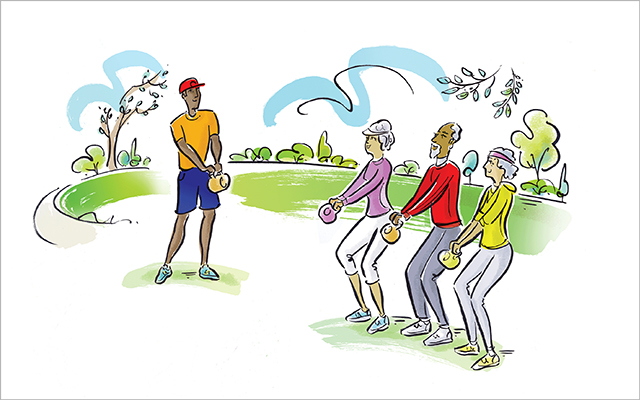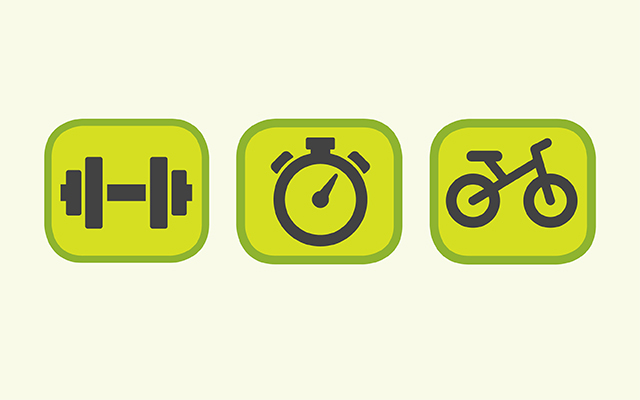| 1. Alertness and Perception 2. Movement and Coordination 3. Attention and Concentration 4. Learning |
5. Memory 6. Creativity and Imagination 7. Exercise and Mental Health 8. A Youthful Brain |
News flash: Exercise isn’t all about your body. In fact, building muscles and conditioning your heart and circulatory system are side effects. Exercise is really about your brain.
Humans evolved to move, and that movement — hunting, foraging, running, climbing — spurred brain growth, especially in the prefrontal cortex, which differentiates us from other animals. “Thinking is the evolutionary internalization of movement,” explains New York University neuroscience professor Rodolfo Llinás, MD, PhD, author of I of the Vortex: From Neurons to Self.
When you’re exercising, your brain is usually not what’s on your mind. But that activity is building your gray matter in myriad ways, making you more alert, creative, motivated, and perceptive, says John Ratey, MD, associate clinical professor of psychiatry at Harvard Medical School. It’s helping you learn better, remember more, and combat stress. It’s boosting your mood while helping you overcome anxiety and depression.
In sum, exercise keeps your brain healthy.
“The real reason we feel so good when we get our blood pumping is that it makes the brain function at its best,” says Ratey, author of Spark: The Revolutionary New Science of Exercise and the Brain. “The point of exercise is to build and condition the brain.”
The reverse is also true, however: “What virtually no one recognizes,” he warns, “is that inactivity is killing our brains.”
Build a Better Brain
Scientists long believed that we’re born with all the neurons we’re ever going to get, and that our brains are hardwired once we pass adolescence. In the last few decades, research has challenged those views.
“We now know that the brain is flexible, or plastic, in the parlance of neuroscientists — more Play-Doh than porcelain,” Ratey explains. Our brains are constantly growing; they can even be rewired. And exercise is the key.
Scientists understand that physical activity stresses our brains similarly to how it works our muscles. Neurons break down, then recover and become stronger and more resilient. “Aerobic exercise can change the brain’s anatomy, physiology — and function,” says New York University neural science professor Wendy Suzuki, PhD, author of Healthy Brain, Happy Life.
Numerous recent studies have revealed just how those changes occur. What’s becoming clear are the many neurological factors that activity positively influences, including the following.
1. Alertness and Perception
The brain is all about communication. It’s composed of 100 billion neurons that confer with each other, governing every thought and action. Synapses are the connections between neurons; they fire electrical signals that neurotransmitters carry to the next neuron’s dendrite branch. Neurotransmitters are thus key to brain function — and they’re strengthened by exercise.
“Exercise is potent,” Ratey says. “More nerve cells fire when we’re exercising than when we’re doing anything else. This activates the brain as a whole. It turns on arousal, attention, the frontal cortex, the executive functioning area — so we’re all set to participate in the world.”
Among these neurotransmitters are norepinephrine, which sparks attention, perception, motivation, and arousal; serotonin, which directs “traffic,” influencing mood, impulsivity, anger, and aggression; and dopamine, which governs attention and learning, plus our sense of contentment and reward.
2. Movement and Coordination
As we move, our brains learn how to move better the next time. Exercise stimulates the cerebellum, which coordinates all the body’s motor movements, like standing upright, hitting a hockey puck, and performing a plié.
The prefrontal cortex is the brain’s CEO, explains Ratey; it’s in charge of executive functions, controlling physical actions, receiving input, and issuing instructions to the body. Managing short-term working memory, judging, and planning are also its responsibility.
“When we exercise, particularly if the exercise requires complex motor movement, we’re also exercising the area of the brain involved in the full suite of cognitive functions,” he explains. “We’re causing the brain to fire signals along the same network of cells, which solidifies their connections.”
3. Attention and Concentration
Our brains become more active when we are active; this causes neurons to fire in unison, creating brain waves. When we’re on autopilot — sleeping, brushing our teeth, watching TV — low-frequency waves prevail. High-frequency waves called beta waves dominate when we’re focused and processing information.
Using electroencephalogram (EEG) monitoring to track electrical pulses, researchers discovered that exercise intensifies brain-wave amplitude and frequency, and more beta waves propel you into a more alert state. “The most common finding in studies on exercise is that increased aerobic exercise will improve your ability to focus attention and your ability to shift your attention,” Suzuki explains.
Experts believe this enhanced focus comes from the bump in dopamine, which calms the mind. Ratey, for example, is convinced physical activity can ease attention deficit disorder (ADD) and attention deficit hyperactivity disorder (ADHD) in kids and adults alike.
4. Learning
The functions of learning and memory are concentrated in the hippocampus, a small region tucked in the brain’s center. But we wouldn’t be able to learn without aid from the prefrontal cortex — part of the reason communication within the brain is so vital.
Neurotrophins build and maintain the brain’s basic cell circuitry. Key among these in the hippocampus is the recently discovered brain-derived neurotrophic factor (BDNF), a protein that incites neuron growth.
“BDNF works in many ways,” Ratey explains. “It makes brain cells work better; it grows them; it prevents them from eroding; it helps deal with stresses; it provides the right environment for brain cells to prosper.” BDNF is released when neurons fire, causing the brain to produce more BDNF. When we exercise, those neurons fire like crazy, elevating BDNF levels.
Physical activity also prompts other hormone factors into action: Insulin-like growth factor (IGF-1), vascular endothelial growth factor, and fibroblast growth factor all push through the blood–brain barrier and work with BDNF to enhance the molecular machinery of learning. In addition, the hormone IGF-1 delivers the brain’s primary fuel — glucose — to neurons to spur learning.
So, while going for a run won’t transform us into geniuses, Ratey says exercise certainly boosts our potential for learning and increases our rate of learning. Both Ratey and Suzuki believe that kids need physical education integrated into classrooms to optimize how they learn.
And for adults? “We don’t have to be looking for that magic pill to make us smarter,” says Suzuki. “We really should be looking for that magic exercise regimen that will optimize all these different brain areas.”
5. Memory
Using magnetic resonance imaging (MRI), Columbia University researchers discovered that BDNF helps the brain create new neurons (a process called neurogenesis) in just two regions: the hippocampus, which is crucial for long-term memory, and the olfactory bulb, the area responsible for smell and taste. This process affects our perception of the world.
In tests on rodents, exercise doubled the rate of neurogenesis in the hippocampus, Suzuki reports. Plus, it increased the number of dendritic spines on the neurons as well as their length — all of which improve neuronal communication.
These physiological changes are called long-term potentiation (LTP), and in further rodent studies, researchers found that exercise-induced LTP improved hippocampal function as measured by a broad range of memory tests.
Other studies have shown similar memory gains for people. In a 2016 report published in Frontiers in Human Neuroscience, researchers conducted MRI scans of cross-country runners and identified “significantly greater connectivity” between parts of their brains associated with attention, decision-making, multitasking, processing sensory input, and memory, compared with a control group of nonrunners.
6. Creativity and Imagination
The hippocampus — which lights up with electrical activity during exercise — also fuels imagination, or thinking about the future and other possibilities. A 2014 study published in the Journal of Experimental Psychology divided 176 college students and adults into two groups, one of which walked while taking a creativity test; the other was sedentary during the test. The walkers scored 81 percent higher.
“We’re not saying walking can turn you into Michelangelo,” says study coauthor Marily Oppezzo, PhD, a Stanford University psychologist. “But it could help you at the beginning stages of creativity.”
Suzuki believes that such a boost in creativity and imagination could help build a better world. “This also raises the possibility that increased exercise might enhance our ability to imagine the future in a new way,” she says.
7. Exercise and Mental Health
Beyond our cognitive abilities, exercise plays a profound role in our mental health. Some theorize that depression is caused at least in part by depleted levels of a category of neurotransmitters called monoamines, which include serotonin, norepinephrine, and dopamine — all of which are magnified by exercise.
“Going for a run is like taking a little bit of Prozac and a little bit of Ritalin because, like the drugs, exercise elevates these neurotransmitters,” says Ratey.
In the process, exercise helps our brains balance hormones. Ratey believes that, along with alleviating depression, this harmonizing of our hormones also inoculates us against toxic stress and eases anxiety. “Keeping your brain in balance can change your life,” he says.
Exercise has other effects on mood, as well. Just as our muscles demand more energy during exercise, our brains gobble up glucose. In a 2016 study published in the Journal of Neuroscience, University of California, Davis, researchers discovered what the brain was doing with all that fuel: making more neurotransmitters.
MRI scans found that levels of glutamate and gamma-aminobutyric acid (GABA) swelled in participants after a stationary-bike session. This may aid in tempering depression, according to lead researcher Richard Maddock, MD, MS, because the stores of glutamate were centered in regions of the brain where the neurotransmitter had been depleted in depressed individuals.
8. A Youthful Brain
All the processes that physical activity induces in the brain add up to one sum: Exercise keeps our brains young. “Everything we’ve learned continues to confirm that exercise helps prevent cognitive decline as we age,” Ratey says. “All the antiaging protocols include exercise in a big way — it’s often the No. 1 lifestyle change to help people prevent aging and cognitive decline.”
Exercise not only makes our brains stronger; it also protects them. Physical activity induces the brain to create enzymes that chew up the amyloid beta-protein plaque that triggers Alzheimer’s by strangling neurons, explains Harvard neurology professor Rudolph Tanzi, PhD, coauthor of Super Brain, a New York Times bestseller.
A new study by Tanzi’s research team suggests exercise also battles inflammation in the brain. A basic immune-system response to injury, inflammation can become chronic as we age, and studies have identified it as a primary agent in Alzheimer’s. Exercise — along with lifestyle changes such as solid nutrition and good sleep — may actually help reverse Alzheimer’s and cognitive decline, Tanzi says.
Finally, among the flurry of research over the past decade is a 2009 study from the University of North Carolina at Chapel Hill, published in the American Journal of Neuroradiology, that used magnetic resonance angiography on 14 participants between the ages of 60 and 74. Those who exercised weekly significantly increased the number of capillaries in their brains compared with a control group. This contributes to optimum brain function — similar to the effects of exercise on healthy muscles.
Lead study author Elizabeth Bullitt, MD, writes, “Our findings suggest that aerobic activity appears to be associated with a ‘younger-appearing brain.’”
Just Move
Ironically, you might want to be sitting down to hear the good news about moving.
While most studies have focused on aerobic exercise and its effects on the brain, recent research suggests that all exercise is beneficial, including resistance training. A 2017 meta-review of studies — coauthored by neuroscientist Wendy Suzuki, PhD, and published in the journal Brain Plasticity — found that just a single bout of exercise benefits your brain. The review, however, doesn’t detail how long that session should be, how intense, or what activities it might include.
Another study showed that just one hour of exercise per week can help prevent depression. The 2017 research published in the American Journal of Psychiatry monitored 33,908 Norwegian adults for 11 years and found lower rates of self-described depression among those who spent an hour a week doing “low-level” exercise.
So what exercise is best? Psychiatrist John Ratey, MD, recommends movements that simultaneously tax your cardiovascular system and your brain — tennis, yoga, dance, Pilates, karate, ice skating, and so on.
“While aerobic exercise elevates neuro-transmitters, creates new blood vessels that pipe in growth factors, and spawns new cells, complex activities put all that material to use by strengthening and expanding networks,” Ratey explains. “The more complex the movements, the more complex the synaptic connections.”
Even though movement creates this new brain circuitry, your brain will recruit it for other tasks, too. “Any motor skill more complicated than walking has to be learned, and thus it challenges the brain,” he says. This is why learning how to play piano makes it easier for people to learn math.
“What it means is that you have the power to change your brain,” he notes. “All you have to do is lace up your running shoes.”
Measuring Brain Activity
3 Pounds: What the typical brain weighs. Human brains have shrunk significantly over the past 20,000 years; the lost volume is equivalent to the size of a tennis ball.
20%: Percentage of the body’s available energy in the form of glucose (sugar) that the brain uses.
15%: Percentage of the body’s blood flow that goes to the brain. Every minute, 750 to 1,000 milliliters of blood flows through the brain, enough to fill a bottle of wine.
100 Billion: Number of neurons in the brain. Neurons govern every thought and action; each neuron can transmit 1,000 nerve impulses per second — and make tens of thousands of synaptic contacts with other neurons.
10%: Percentage of our brains that popular mythology says we use. Modern brain scans, however, show we use most of our brains most of the time — even when we’re sleeping.
This originally appeared as “Your Brain on Exercise” in the May 2018 issue of Experience Life.




This Post Has 2 Comments
What a great article!! Short, kind of, and to the point. Covered a lot of areas of the brain that are really simple to understand . More importantly it showed just how important exercise is to those areas. It’s not just ” it does a brain good” anymore. This shows that it’s absolutely essential!! I hope a lot of people read this. Thanks for your service.
Craig
I have always made physical activity a priority. I’m soon to be 76 and I walk my dog 5 miles a day. I am so thankful that I can walk and bike at my age. I am convinced that the only reason I am able to be active at my age is my life long dedication to physical activity. While I cannot run like I could in the past, my daily walks and biking bring me great joy.